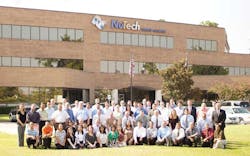AN INTERVIEW WITH NUTECH’S ALLEN HOWARD
EDITOR’S NOTE: Allen Howard is one of the world’s foremost authorities on oil and gas reservoirs. As president and CEO of NuTech Energy Alliance, his aim is to share his company’s knowledge and help the petroleum industry use its resources more efficiently. We caught up with him in August at Summer NAPE in Houston.
OIL & GAS FINANCIAL JOURNAL: Allen, we hear a lot about NuTech Energy Alliance and the great work your engineers and geoscientists are doing to help improve reservoir analysis in shale plays and elsewhere. Can you give our readers some background on NuTech and what it is your company does?
ALLEN HOWARD: The original concept I had for NuTech began as early as 1995 while working with various technologies in the area of pore size relationships. This concept was actually put into a plan at my kitchen table in 1997 and further vetted for industry release in 1998. The unique pore size, or textural, models we created combined historical measured data with new technology to become the centerpiece for how NuTech defines and understands the reservoir.
Over a 15-year period we have evolved into an integrated reservoir evaluation company providing petrophysics, stimulation design, geomechanical relationships, core laboratory services, reservoir engineering, and characterization models. Each step of our analysis utilizes a process designed to continually capture more understanding about the reservoir. We think this process is key to producing consistent results for decision making.
To date we have analyzed more than 60,000 wells in virtually every known basin around the globe. This experience has allowed NuTech to gain knowledge and insight into how reservoirs can be more properly evaluated and managed.
OGFJ: How does NuTech differentiate itself from competitors? What is your special expertise?
HOWARD: The main difference is that NuTech was founded upon a unique approach to understanding textural modeling of the reservoir through petrophysics. Texture describes how we break down the pore system into different components (small to large) to understand how to properly assess the reservoir from key quantitative attributes such as affective porosity, clay, permeability, and saturations. Texture allows NuTech to solve the complex reservoir issues that prevent our industry from identifying and de-risking bypass pay.
When we build a reservoir model that utilizes all of the key elements, we tap into intel that helps us interpret and further develop the reservoir. We refer to this new set of eyes that we lay on the reservoir as "Reservoir Intelligence. We use this approach in many ways, but one of the most dramatic is to shorten the learning curve in any unconventional play. Another critical application is to understand the risk our clients face in order to maximize their value at any point because of our understanding of the variables in shale evaluation. When we make a bold, forward-looking statement concerning an unconventional reservoir, we do so based upon our expertise.
OGFJ: At what stage does NuTech start advising its clients about the subsurface rock on their leaseholds? How does this impact development?
HOWARD: We typically get involved in the early phase of client activity— whether a client is involved in old field rejuvenation, analyzing or de-risking new and existing shale plays, or incorporating advisory services in the early phase of strategic planning. During the early stages of positioning or lease acquisition, NuTech enhances pre-existing well data ahead of the bit to help establish our high-level property distribution model across a prospective area. For example, we utilized hundreds of historical wells for control points to help identify the Eagle Ford formation back in 2007. This pre-existing data contributed key attributes for property distributions in order to understand the continuity of the play and define some of the variability prior to leasing or considering development.
OGFJ: For the non-geologists among us, can you talk a little about the physical characteristics of two or three shale reservoirs and how best to approach them to maximize productivity and make it more economic?
HOWARD: I believe the most critical attributes in the evaluation of any shale play are maturity, free hydrocarbon pore volume, the textural relationship to permeability, and rock competency, which combines the relationship between stress, brittleness, and mineralogy. The Eagle Ford, Utica, and Bakken shale plays all demonstrate high reservoir quality with these critical and calibrated attributes.
We have experience with shales that trend toward higher elasticity that computes lower clay and higher silt, which typically yields much larger storage capacity. In these environments we have achieved commercial success through advanced studies with fracture calibration. This is why reservoir intelligence is critical in the early stages of shale opportunities. Our primary goal at NuTech is to protect client investments by pre-defining the reservoir’s primary characteristics and variability before executing the development plan.
From left: Will Deaton, VP client services; Britt Hill, EVP, COO; Allen D. Howard II, EVP, chief commercial officer; Allen Howard, president, CEO; Steve Roth, EVP, chief marketing officer
OGFJ: Geology can be quite different within a particular shale formation, which can affect drilling and completion techniques. What are some of the methods NuTech uses to identify "sweet spots and differentiate them from other less desirable locations?
HOWARD: The most consistency I have experienced in a shale play is inconsistency, and in some cases within the same well. We have learned that variability is the way of life when developing a shale "sweet spot. We have had to learn how to deal with such variability by utilizing a geologically-engineered approach to distributing the most key shale characteristics.
In most cases, we have to layer in reservoir-managed strategies to keep the operator in control of the development process. Once we have identified the shale sweet spot with these key characteristics we move quickly to completion design and strategies through a calibrated, closed loop learning process referred to as stimulation vision. I feel that the biggest step in the successful development of a new shale play is how quickly we can gain understanding of the completion learning curve. We have been fortunate since our first shale model was developed and released in 2002 in identifying successful shales throughout the world versus the ones that are not ready to be produced with current technology.
OGFJ: We hear a lot about "science wells and how several of these vertical wells must be drilled to learn more about the formation before horizontal drilling commences for commercial development. What can be learned from science wells and how important is this to operators and producers?
HOWARD: We call these "proof of concept wells, and they are used to collect all appropriate data to ensure the play has the correct attributes to be a success. This benchmark strategy allows the oil company to develop a plan to move forward. These strategies are performed by all shale players as acceptable practice.
NuTech’s approach to the proof of concept strategy is to create better calibration of older recorded data that can be utilized to understand reservoir characterization. We build confidence around key parameters from pre-existing wells so that they live and breathe as though they are new drills. These wells now become accepted data points and are invaluable because they assist in improving property distribution across the play.
Prior to drilling any proof of concept well, the placement or location work is quite strategic. We work with clients to place the wells correctly because we want to tie the resulting data points back into a model that adds value to the entire reservoir.
OGFJ: I understand that NuTech has several principal services for reservoir evaluation. Can you give our readers a brief description of each and tell what benefits they provide?
HOWARD: We have constructed a series of reservoir services that are applied to our intelligence system as hooks in order to execute a specific, well placement, reservoir strategy. Each of these services can then be adapted to solve a particular reservoir issue that our clients need to address in each phase of the process from early decision risks to execution.
Over the past six years we have witnessed companies focusing only on the same reservoir tools at hand and repeatedly discounting others. At NuTech, our focus is to establish a full spectrum evaluation through a step-by-step process that combines real Reservoir Intelligence and its collective power.
OGFJ: How much better are we able to analyze hydrocarbon reservoirs today than just a few years ago and how has this impacted the upstream sector?
HOWARD: I have always worked on the leading edge of technology— from my early years at Schlumberger, to the advancement of magnetic resonance via NUMAR, and now to textural reservoir modeling here at NuTech. Reservoir engineering analysis to completion technology has made the difference in today’s shale markets. We have observed tremendous strides in these technologies and have made achievements in shortening the expensive learning curve in key markets down from seven years for instance in the Barnett in the Fort Worth basin to less than two years in the Eagle Ford play in South Texas.
NuTech’s main objective in these types of plays is to impact the industry’s best practice strategies early in the decision process through final execution. Our abilities have allowed us to capture, identify, quantify, and ultimately understand all the high-risk properties of major shales. From this we have created an expertise that impacts economics by focusing our attention on improving performance through recoverability.
OGFJ: What do you see as the most exciting or interesting emerging resource play on the horizon?
HOWARD: Excellent question. I think that expresses the interest and heartbeat of the industry. From my personal perspective from the tremendous amount of work we have analyzed, there are about three or four plays in the Permian basin that are not quite there technically. When the strategies are properly understood and implemented, you will see some of the best reserves per well in the world.
OGFJ: Science and technology have brought about a renaissance of domestic oil and gas production in the United States. In your view, what are the overall implications of this? Can we achieve a measure of energy independence by reducing oil imports dramatically?
HOWARD: I believe innovative steps in technology, both primary and secondary, will continue to help us move towards energy independence, and NuTech has been a part of that technological renaissance. If we look at the 1,200 successful shale completions the industry has brought on line since 2008, we have stopped the nation’s production decline. The impact is already being realized with increasing production at 1.5 million barrels of oil per day.
Within the service and technology sector, let’s look at the impact from real world examples. In Cotulla, in La Salle County Texas (Eagle Ford shale play), there is a whole city being built overnight because of similar successes. That is a real economic impact beyond the oil reserves identified.
OGFJ: Is most of NuTech’s business today in the United States? What are some of the other countries in which you operate, and how do you expect this will change in the coming years? Please elaborate, if you will.
HOWARD: Yes, a high percentage of our business is from North America. But I do like the fact that based upon our technical advantage, we were seeing prospective shale plays as early as 2006 in South America and European basins. In fact, we were ahead of the charge in places like Colombia and Argentina, but we faced an early but common attitude that these rocks would not produce. This delayed progress until they saw what happened with shale in the US. Now, many of those same reservoirs we initially analyzed are being hailed as world-class shale plays.
We are seeing major shifts in our international business strategy. Our partnership with Chevron Lummus Global supports our strategy to provide our reservoir understanding to projects and clients that may be lacking technical expertise and certainly unconventional experience.
NuTech’s family of nearly 100 geoscientists and engineers in front of the main office in Houston. The company has other offices in Dallas, Denver, Oklahoma City, Calgary, London, and Mexico.
When it comes to international plays, we are only seeing the tip of the iceberg. Aside from our market presence in South America and Europe, we are expanding our popular catalogue of domestic unconventional reservoir studies by completing studies in the United Kingdom and Poland. In fact, we are currently assessing finding what we think will be one of the larger shale opportunities in the UK.
OGFJ: What is the next big step for the petroleum industry and how will it be impacted by reservoir analysis and well analysis?
HOWARD: I believe that shale development will be at the forefront of capital expenditures over the next 10 years. We are still in the early stages of understanding shale reservoirs, learning what is necessary to enhance production, and studying how to increase recoverability. Secondary and possibly tertiary completion strategies will ultimately be the next big step. Early-phase pilots have given positive results in some markets, but there still is a long way to go.
From a NuTech perspective, we want to use Reservoir Intelligence to lead the charge to developing better reservoir strategies to understand plays early and before major capital is invested. Our approach also helps steer clients toward plays that are more likely to be successful, as opposed to so many shales that don’t currently work.
OGFJ: What is the next big step for NuTech as a company?
HOWARD: Our plan is to continue growing through expanding offices into key locations around the world and expanding our advisory services platform through strategic alliances with other key industry service players. Since the expertise in many of the key global markets is limited, we are being asked to provide advisory services that address those limitations.
Specifically, we see growth coming in Russia, South America, and Australia. But our key goal is to connect key global markets to what we have already learned from every important shale play in the US. We have already started this through a strategic alliance with Chevron Lummus Global, teaming with them to add integrated planning strategies from reservoir exploration through refinery. We signed a five-year contract with them, which is essentially a joint venture. CB&I (Chicago Bridge & Iron) is also part of this consortium, and we are working with them in Colombia. It just makes sense for us to share our expertise on reservoirs and the upstream sector with the companies that are designing and building midstream infrastructure and refineries that will take the production to various markets.
OGFJ: Thanks for taking time to talk with us.



